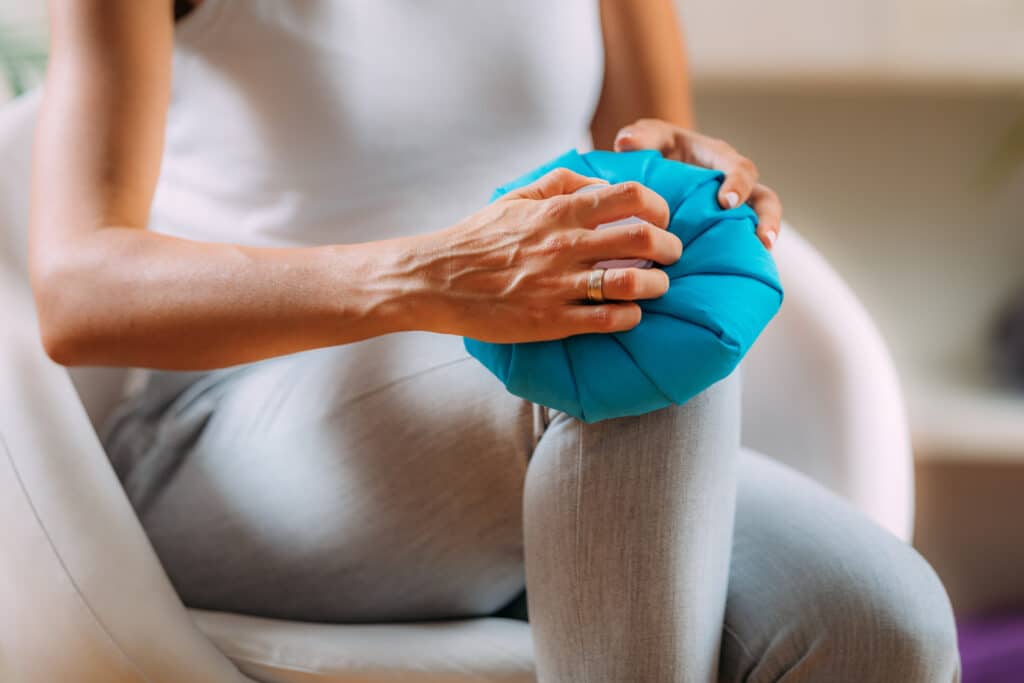As a specialist doctor, I often hear the question: “Should I use ice or heat for knee pain?” Over the years, I’ve treated countless patients with knee pain caused by injuries, arthritis, or overuse. From my personal experience, the right treatment depends on the cause of your knee pain.
Let’s break it down so you know when to use ice, when to use heat, and how to maximize relief.
Understanding Knee Pain

Knee pain is a common issue that affects people of all ages. It can result from injuries, medical conditions, or daily wear and tear. Some common causes include:
- Injuries – Sprains, ligament tears (like ACL or MCL injuries), meniscus tears
- Arthritis – Osteoarthritis, rheumatoid arthritis, or gout
- Overuse – Pain from excessive walking, running, or standing
- Tendonitis & Bursitis – Inflammation of tendons or bursae (fluid-filled sacs in the knee)
One of the simplest and most effective treatments I recommend to my patients is temperature therapy – using ice or heat. But using the wrong one at the wrong time can make things worse.
When to Use Ice for Knee Pain
Ice therapy (also called cryotherapy) helps reduce inflammation and numbs pain. I usually advise patients to use ice in the following situations:
1. Right After an Injury
If you have just injured your knee (like twisting it while playing sports), ice is your best friend. It slows down blood flow, reducing swelling and pain.
2. For Swelling and Inflammation
If your knee looks swollen, red, or feels warm to the touch, ice can help calm things down. I’ve seen patients who ignored swelling and ended up with more severe pain later. Applying ice early can prevent that.
3. After Intense Activity
If you’ve overused your knee—maybe after a long hike or a heavy workout—icing can help reduce muscle soreness and prevent inflammation.
How to Use Ice Properly:
- Wrap an ice pack (or a bag of frozen peas) in a thin towel.
- Apply to the knee for 15-20 minutes every 2-3 hours.
- Never apply ice directly to the skin to avoid frostbite.
I once treated an athlete who had a swollen knee after a football match. He iced it properly, and within a couple of days, his swelling reduced significantly. Proper icing can speed up recovery.
When to Use Heat for Knee Pain
Heat therapy improves blood flow and relaxes muscles and joints. I recommend heat therapy in these situations:
1. For Stiff or Tight Knees
If your knee feels stiff when you wake up in the morning or after sitting for a long time, heat can help loosen the joint and improve mobility.
2. For Chronic Arthritis Pain
Patients with osteoarthritis or rheumatoid arthritis often feel worse in cold weather. Heat therapy can provide comfort and reduce pain.
3. Before Exercise or Stretching
Using heat before activity can prepare your knee for movement by increasing flexibility and blood circulation.
How to Use Heat Properly:
- Use a heating pad, warm towel, or hot water bottle.
- Apply for 15-20 minutes at a comfortable temperature.
- Avoid using heat on a swollen or inflamed knee.
A patient of mine with chronic arthritis found that using a heating pad in the morning made it easier for her to start the day with less pain and stiffness. Heat works wonders for long-term joint issues.
Ice vs. Heat: A Quick Comparison Guide
| Condition | Use Ice ❄️ | Use Heat 🔥 |
| New injury (first 48 hours) | ✅ Best choice | ❌ Avoid |
| Swelling & inflammation | ✅ Best choice | ❌ Avoid |
| Arthritis pain | ❌ Avoid | ✅ Best choice |
| Muscle stiffness | ❌ Avoid | ✅ Best choice |
| Before exercise | ❌ Avoid | ✅ Best choice |
| After intense activity | ✅ Best choice | ❌ Avoid |
When to Avoid Ice or Heat
- Don’t use ice if you have poor circulation or nerve damage, as it may worsen the condition.
- Don’t use heat on a swollen, red, or inflamed knee, as it can increase swelling.
- If you have diabetes or vascular disease, consult a doctor before using heat or ice therapy.
I once had a patient with neuropathy (nerve damage) who used an ice pack for too long and ended up with skin damage. Always be careful and follow time limits.
Also Read: How To Heal A Sprained Knee Quickly – Expert Tips for Quick Recovery!
Can You Use Ice and Heat Together?
Yes! Alternating ice and heat—called contrast therapy—can be effective. Here’s how:
- Start with ice for 10–15 minutes to reduce swelling.
- Wait 30 minutes, then apply heat for another 15 minutes.
- Repeat as needed, but always listen to your body.
This method works well for post-workout soreness and arthritis pain. I’ve used it myself after long shifts in the hospital when my knees feel sore from standing all day.
Other Ways to Manage Knee Pain
While ice and heat therapy are great, they work best when combined with:
- Rest & Elevation – Reduce strain on your knee by keeping it elevated.
- Compression – A knee brace or bandage can provide extra support.
- Gentle Exercise – Strengthening muscles around the knee can prevent future pain.
- Anti-inflammatory Medication – If needed, medications like ibuprofen can help.
FAQ’s
1. Should I use ice or heat for knee pain?
Use ice for swelling or recent injuries and heat for stiffness or chronic pain like arthritis.
2. Can I use both ice and heat for knee pain?
Yes, alternating ice and heat (contrast therapy) can help reduce pain and improve circulation.
3. How long should I apply ice or heat to my knee?
Apply ice or heat for 15-20 minutes at a time, with breaks in between to avoid skin damage.
4. When should I avoid using ice or heat?
Avoid ice if you have poor circulation and heat if your knee is swollen, red, or inflamed.
5. What if my knee pain doesn’t improve with ice or heat?
If the pain persists or worsens, see a doctor to rule out serious conditions like ligament injuries or arthritis.
Final Thoughts: Ice or Heat – Which One Should You Use?
If your knee is swollen or recently injured, use ice. If it feels stiff, sore, or affected by arthritis, use heat. Both methods can help when used correctly. I always tell my patients to listen to their bodies—if something makes the pain worse, stop and try a different approach. Knee pain can be frustrating, but with proper care, you can stay active and pain-free. If the pain doesn’t improve, it’s best to see a specialist.






